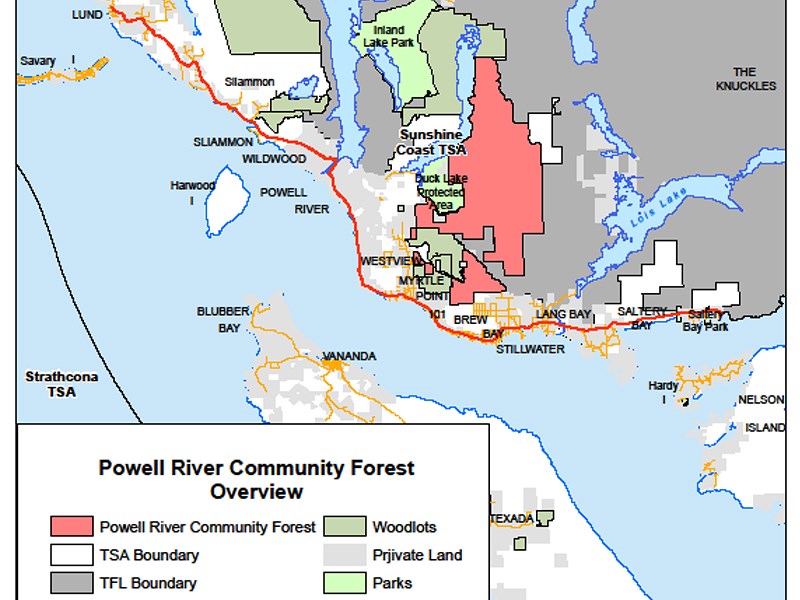The amount of timber coming out of Powell River’s community forest is slated to increase by almost half after the BC government signed off on its latest management plan this summer.
City of Powell River’s committee of the whole received a letter from Powell River Community Forest president Greg Hemphill at its meeting on Tuesday, December 13. The letter states that in July, BC Ministry of Forests, Lands and Natural Resource Operations approved the community forest board’s latest management plan for the 7,100-hectare forestland located east of the city and the Duck Lake Protected Area.
Powell River Community Forest is a wholly-owned subsidiary of the city. The management plan is the culmination of a review process the board initiated over three years ago, wrote Hemphill.
“Our overriding objective for the process was to ensure forest practices on the community forest are fully sustainable over the long term,” he stated in the letter.
The board hired forestry consultants to create a timber-supply analysis that mapped and tracked the forest’s inventory of tree types, heights and sizes.
The community forest is “fortunate to have a very stable short- and long-term timber supply,” stated Hemphill.
A key aspect of the management plan is an increase to the woodland’s annual allowable cut from 25,000 to 35,000 cubic metres.
Hemphill acknowledged the 40 per cent increase was conservative, based on recommendations from the supply analysis that suggested the increase could have been as high as 57 per cent and still remain sustainable.
According to former provincial chief forester Jim Snetsinger, the community forest board can feel comfortable that the forest can be sustainably managed at a level between 35,000 to 40,000 cubic metres per year. Snetsinger was contracted to review the findings of the supply-analysis report and help the board through the provincial process of setting a new annual allowable cut level. He warned in his report that despite starting out a decade ago with a high level of public support, a potential risk of setting the allowable cut too high would be “to cause some negative public reaction.”
City of Powell River councillor and finance committee chair Russell Brewer said at the meeting that the annual cut increase would have a significant economic impact for the city.
“All things being equal, this will mean a 40 per cent increase in dividends as well,” Brewer told the committee.
Hemphill noted in his letter the increase will lead to “a significant boost in economic benefits to the community” through increased employment and supply purchases. However, he cautioned that when it comes to annual financial projections, annual cut levels are “often not the most significant factor,” noting the variability of the forest product markets.
Brewer said he appreciates the board’s approach with regard to setting cut levels in the forest and said it might be time for the community-forest model to be revisited.
After a decade of funding capital projects, it may be time to have a discussion on the long-term use of that dividend, he said.
Since 2006, when the community forest was established, it has provided more than $6 million in dividends to pay for more than 60 community projects.
“It’s great and the dividend goes to a lot of excellent community projects, but I am concerned that those projects have lifetime cycle of costs associated with them,” said Brewer. “If we keep sinking all of the dividend into capital projects, then at some point there are all those lifecycle costs that will catch up.”
Brewer said he would like to see at least some of the funds used to address some of the city’s social-planning issues and go toward replenishing the city’s reserve funds.
“We need to start talking about our reserves and building up the plan B for the ‘what-if’ scenarios,” he added. “We haven’t really tackled that in a big way yet.”



